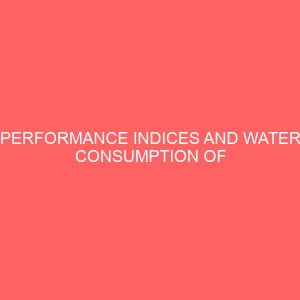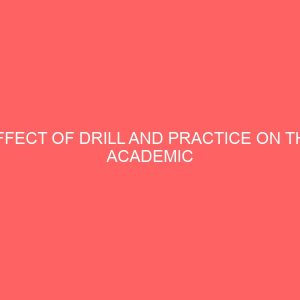Description
PREAMBLE
This guide is on Free complete faculty of Education Research Project Manual and Format. Research project is an important condition to be satisfied before any student can graduate from a programme of study in a tertiary educational institution. Research project writing is a painstaking exercise that systematically addresses the solution to a specified problem of study. It is usually guided by a format and varies from one educational institution to another. However, the basic ingredients are essentially the same. It is often highly regrettable that most students fail to abide by the rubrics of project writing or to give it the maximum attention it deserves. Some even play down on the guidance of their supervisors while adopting some edge-cutting approaches, which are indeed, counter-productive.
This Research Project Manual and Format of Writing and Presenting a Research Report, which is presented in a simplified and well-illustrated manner, is meant to guide students and their supervisors on the acceptable standards expected of them in conducting a research project. The primary aim of the Manual is to provide a description of the various components of writing a research project. It has two parts. Part one presents the full details of the component parts of a research report, starting from the preliminary pages, the major chapters and sub-headings, and the explanation of how to conduct a research project. Part two outlines the format of writing and presenting a research report. The entire booklet Manual captures the essence of writing a good research report as well as other details needed at various levels of study (undergraduate, PGDE, M.Ed and PhD), as approved by the Faculty of Education, National Open University of Nigeria, with effect from 2019 academic session. It is therefore, expected that Study Centre Directors and project Supervisors should adopt the manual and give the contents the widest publicity it deserves, as a tool for guiding students in research project writing.
Part 1
HOW TO CONDUCT A RESEARCH PROJECT
PRELIMINARY PAGES
- Title (Project/Dissertation/Thesis title should contain maximum of 23 words)
- Declaration
- Certification
- Dedication
- Acknowledgements
- Table of Contents
- List of Tables
- List of Figures (If any)
- Abstract
The abstract is written as a mini-paper, i.e., it contains the following information in this order:
Introduction: a few sentences to provide background information on the study. Methods: techniques used. Results: the major results of the study, and recommendations.
CHAPTER ONE INTRODUCTION
1.1 Background to the Study
The background sets the general tone for your study. The researcher is expected to discuss in detail and convincingly the background, need and rationale for the topic. It should start by introducing the broad overall topic and providing basic background information surrounding the dependent variable of interest from a global approach and narrowing the topic down to a more specific research context. In other words, this should have a funnel structure.
1.2 Statement of the Problem
Inform the reader of the specific problem under study. This should flow from gaps existing and how the present study will fill that gap.
1.3 Purpose of the Study
The purpose of the study is usually an amplification of the title. Let us consider one example:
“Gender Differences in Senior School Certificate Examination Chemistry in Ikorodu
Local Government Area of Lagos State”
The purpose of the study can be stated thus:
The purpose of this study is to examine the gender influence on academic performance of students in Senior School Certificate Examination Chemistry in Ikorodu Local Government Area of Lagos State. The specific objectives are as follows:
- To assess the extent to which male and female students differ in their
Chemistry performance in the Senior School Certificate Examination
- To determine the influence of home background on students‟ Chemistry performance in the Senior School Certificate Examination
- To find out if the type of school that students attend can influence their academic performance in Senior School Certificate Examination Chemistry
- To examine……………………………………………………………
Always begin your statement of purpose with: The purpose of this study is to…………
The specific objectives should be based on the number of variables of your study. For instance in our example, we have used the variables of gender, home background, and school type to further expand the scope of our study. Ensure that the variables you have selected are relevant to your study. Now, from your understanding of our discussion, provide a suitable variable to form the fourth objective in the example above.
1.4 Research Questions and /or Hypotheses
The „Research Questions‟ is a question format of the objectives e.g. using the example above:
- To what extent would male and female students differ in their Chemistry performance in the Senior School Certificate Examination?
The „Hypotheses‟ is a testable form of the objectives and must be stated in the null form be accepted or rejected at the point of testing; e.g. using the example above:
- There is no significant difference between male and female students in their Chemistry performance in the Senior School Certificate Examination.
- Significance of the Study
Indicate those that will benefit from findings of the study and how.
- Scope of the Study
The scope of the study should cover both the content scope and geographical scope.
- Operational Definition of Terms
State clearly the definitions of some variables that might be confusing to the reader.
CHAPTER TWO REVIEW OF RELATED LITERATURE
Begin this chapter thus:
.
This chapter deals with the review of literature considered important to this study. The literature review is discussed under the following sub-headings:
2.1 Conceptual Framework
2.2 Theoretical Framework
2.3 Empirical studies using relevant sub-head8ings
2.4 Appraisal of the Reviewed Literature
2.1 Conceptual Framework
The conceptual model of the study should be provided here with explanation of linkages.
2.2 Theoretical Framework
Here you should have a review of the major theory or theories related to the topic and indicate the relevance of the theories to your study.
2.3 Empirical studies using relevant sub-headings
Empirical studies are abstract-like in nature. It should indicate the purpose of study, sample and sampling technique, instruments for data collection, method of data analysis, and major findings of the studies reviewed. Ensure that the studies you are reviewing are related to your research work.
2.4 Appraisal of Reviewed Literature
The literature reviewed should be summarized. You should also indicate the gap in literature that justifies your own study.
CHAPTER THREE METHODOLOGY
Start with an introductory statement such as this:
In this chapter, the processes and procedures that were followed in carrying out the study are discussed under the following sub-headings:
3.1 Research Design
3.2 Population of the Study
3.3 Sample and Sampling Techniques
3.4 Instrument for Data Collection
3.5 Validity of the Instrument
3.6 Reliability of the Instrument
3.7 Procedure for Data Collection
3.8 Method of Data Analysis
3.1 Research Design
State the design you want to use and the justification for such design.
3.2 Population of the Study
The totality of all the respondents to whom the findings of the study will be generalized. Provide the population of the study that make up your study.
3.3 Sample and Sampling Techniques
The sample refers to a section of the population that was used for the study. The sampling technique discusses the techniques you have adopted in choosing the sample from the population. Indicate your sample size. Also, the technique used in selecting the sample should be stated and you should give justification for the adoption of such technique as it relates to your study.
3.4 Instrument for Data Collection
You should describe in detail all the instruments used in collecting the data for the project. These may include questionnaire, interview schedules, sociometric instruments, rating scales, tests, government documents, etc. The instrument should be explained including how it is patterned, sectioned and scaled in terms of expected responses and weightings.
3.5 Validity of the Instrument
The processes involved in the validation of your instruments should be explained in details. This is mostly based on the face and content validity, construct validity, concurrent validity, etc., depending on the nature of your study.
3.6 Reliability of the Instrument
Explain the method of reliability, how it was done and the results obtained. There should be an explanation of the type of reliability that was undertaken and its justification. This could be test-retest, split half or some other methods, depending on the nature of your study.
3.7 Procedure for Data Collection
This section describes step by step how the instruments were administered. i.e. give the details of how the data collection was carried out
3.8 Method of Data Analysis
State the statistical tools used in the analysis such as percentages, frequency counts, mean, standard deviation, chi-square test, t-test, analysis of variance (ANOVA), bar charts, pie charts, histogram, graphs, etc. and justify the selection of such method, depending on the nature of your study
CHAPTER FOUR
RESULTS
This is where you report your findings and present them in a systematic manner. It should be reported in sufficient detail to justify any conclusion. The use of tables and figures must be judiciously employed to present summaries. Number the tables in the order of occurrence in the text. In referring to the tables or figures use such phrases as „see Table 2‟ or „as shown in Table 2‟. Avoid such references as „the table below‟ or „the table above‟.
Start Results section with an introductory statement such as this:
The results of the study are presented in accordance with the research questions and hypotheses.
4.1 Answers to the Research Questions
4.1.1 Research Question 1
4.1.2 Research Question 2
4.1.3 Research Question 3 etc.
4.2 Testing of Hypotheses
4.2.1 Hypothesis 1
4.2.2 Hypothesis 2
4.2.3 Hypothesis 3
etc.
4.3 Summary of the Findings
Summarize the findings by listing them out, point by point. You can use any of these sentences as your introductory statement:
The following are the major findings: or The results revealed the following major findings: or Based on the analysis of data the following findings emerged
CHAPTER FIVE DISCUSSION, CONCLUSION AND RECOMMENDATIONS
After presenting results and analysis, the researcher is now in a position to discuss findings and draw conclusions and implications.
Start with an introductory statement such as this:
This chapter presents Discussion of the findings, Conclusion, Implications of the study, Recommendations, Contribution to knowledge and Suggestions for further study.
5.1 Discussion of the Findings
This is where you elaborate on your findings, and explain what you found (in the case of research questions) or start with a clear statement in support or non-support of the main hypotheses of the project. Areas of similarities and differences between the results and the work of others should be stated, adding your own personal interpretations. In discussing the findings, you are required to accomplish three things (1) state what your findings are (2) discuss how each finding agrees or disagrees with the previous research mentioned in the literature review and then (3) put your work into perspective by justifying why your own findings agree or disagree with the work of others. For instance, if there are five set of findings in your study, you should discuss each finding based on the three points listed above, addressing each finding individually.
5.2 Implications of the Study
Describe the practical implications of the study to your field/area.
5.3 Conclusion
Draw up a summary of the entire work as your conclusion.
5.4 Recommendations
This should flow from the findings of your study.
5.5 Contribution to Knowledge (M.ED. and Ph.D Students only)
What contribution has the project made or added to existing knowledge. How has the study helped to resolve the original problems which led to the investigation.
5.6 Suggestions for Further Study
Indicate the possible dimensions that your work could address.
REFERENCES
- APA format should be strictly adhered to.
- All literature/illustrations/figures used must be well cited. Students must be conscious of plagiarism.
APPENDICES
Order of Arrangement
- Letter of Introduction from Head of Department to the field
- Letter of Attestation from the field i.e. where the study was carried out – Instruments/Packages








Reviews
There are no reviews yet.